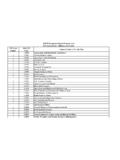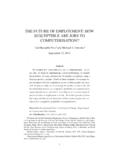Transcription of PARLIAMENT AND THE COUNCIL Data protection rules as a ...
1 EUROPEAN. COMMISSION. Brussels, COM(2019) 374 final COMMUNICATION FROM THE COMMISSION TO THE EUROPEAN. PARLIAMENT AND THE COUNCIL . Data protection rules as a trust-enabler in the EU and beyond taking stock EN EN. Communication from the Commission to the European PARLIAMENT and the COUNCIL Data protection rules as a trust-enabler in the EU and beyond taking stock I. Introduction The General Data protection Regulation1 (hereafter the Regulation') applies across the European Union since over one year. It is at the centre of a coherent and modernised EU data protection landscape that also includes the Data protection Law Enforcement Directive2 and the Data protection Regulation for EU institutions and bodies3. This framework is to be completed by the e-Privacy Regulation which is currently in the legislative process. Strong data protection rules are essential to guarantee the fundamental right to the protection of personal data.
2 They are central to a democratic society4 and an important component of an increasingly data-driven economy. The EU aspires to seize the many opportunities that the digital transformation offers in terms of services, jobs and innovation, while at the same time tackling the challenges these bring. Identity theft, leaks of sensitive data, discrimination of individuals, in-built bias, sharing illegal content and the development of intrusive surveillance tools are just a few examples of issues that increasingly feature in the public debate where it is clear that people expect their data to be protected. Data protection has become a truly global phenomenon as people around the world increasingly cherish and value the protection and security of their data. Many countries have adopted or are in the process of adopting comprehensive data protection rules based on principles similar to those of the Regulation, resulting in a global convergence of data protection rules .
3 This offers new opportunities to facilitate data flows, between commercial operators or public authorities, while improving the level of protection for the personal data in the EU and across the globe. 1. Regulation (EU) 2016/679 of the European PARLIAMENT and of the COUNCIL of 27 April 2016 on the protection of natural persons with regard to the processing of personal data and on the free movement of such data, and repealing Directive 95/46/EC (General Data protection Regulation) (OJ L 119, , p. 1): https://eur- 2. Directive (EU) 2016/680 of the European PARLIAMENT and of the COUNCIL of 27 April 2016 on the protection of natural persons with regard to the processing of personal data by competent authorities for the purposes of the prevention, investigation, detection or prosecution of criminal offences or the execution of criminal penalties, and on the free movement of such data, and repealing COUNCIL Framework Decision 2008/977/JHA, OJ L 119, : :32016L0680.
4 The Directive had to be transposed by Member States by 6 May 2018. The Security Union Reports provide the state of play on its transposition. 3. Regulation (EU) 2018/1725 of the European PARLIAMENT and of the COUNCIL of 23 October 2018 on the protection of natural persons with regard to the processing of personal data by the Union institutions, bodies, offices and agencies and on the free movement of such data, and repealing Regulation (EC) No 45/2001 and Decision No 1247/2002/EC, OJ L 295, , p. 39-98: content/EN/TXT/?uri=CELEX%3A32018R1725. It became applicable on 11 December 2018. 4. The Indian Supreme Court, in a landmark judgment of 24 August 2017, recognised privacy as a fundamental right, an essential facet of the dignity of the human being'. 1. Data protection is taken more seriously than ever before and it has a wide-ranging impact on different stakeholders and sectors. The Commission is determined to lead the EU to a successful implementation of the new data protection regime and to support all aspects of it becoming fully operational.
5 With this Communication, the Commission takes stock of the results achieved so far as in relation to the consistent implementation of the data protection rules across the EU, the functioning of the new governance system, the impact on citizens and businesses and the EU's efforts in promoting global convergence of data protection regimes. It follows-up on the Commission Communication on the application of the Regulation of January 20185, and it has been informed by the work of the Multi-stakeholder Group6, in particular its contribution to the one-year stocktaking exercise as well as the discussions held at the stocktaking event organised by the Commission on 13 June 20197. This Communication is also a contribution to the review that the Commission plans to carry out by May 2020 8. The EU data protection legislative framework is a cornerstone of the European human-centric approach to innovation. It is becoming part of the regulatory floor for a widening range of policies including health and research, artificial intelligence, transport, energy, competition and law enforcement.
6 The Commission has consistently emphasised the importance of a proper implementation and enforcement of the new data protection rules , as highlighted in its Communication on the application of the Regulation issued in January 2018 and its Guidance on the use of personal data in the electoral context published in September 20189. At the time of this Communication, a lot of progress had been made towards this objective, although more work is certainly needed for the Regulation to become fully operational. II. One continent, one law: the data protection framework is in place in Member States One key objective of the Regulation was to do away with a fragmented landscape of 28. different national laws that existed under the previous Data protection Directive 10 and to provide legal certainty for individuals and businesses throughout the EU. That objective has been largely met. 5. Communication from the Commission to the European PARLIAMENT and the COUNCIL Stronger protection , new opportunities Commission guidance on the direct application of the General Data protection Regulation as of 25 May 2018', COM(2018) 43 final: 6.
7 The Multi-stakeholder Group on the Regulation set up by the Commission involves civil society and business representatives, academics and practitioners: 7. 8. Article 97 of the Regulation. 9. Commission guidance on the application of Union data protection law in the electoral context', COM(2018) 638 final: 10. Directive 95/46/EC of the European PARLIAMENT and of the COUNCIL of 24 October 1995 on the protection of individuals with regard to the processing of personal data and on the free movement of such data :31995L0046. 2. The harmonisation of the legal framework Although the Regulation is directly applicable in the Member States, it obliged them to take a number of legal steps at national level, in particular to set up and allocate powers to the national data protection authorities11, lay down rules on specific issues, such as the reconciliation of the protection of personal data with freedom of expression and information, and amend or repeal sectoral legislation with data protection aspects.
8 At the time of this Communication, all but three12 Member States had updated their national data protection law. Work on adapting sectoral laws is still on-going at national level. Following its incorporation in the European Economic Area Agreement, the application of the Regulation was extended to Norway, Iceland and Lichtenstein which have also adopted their national data protection law. However, stakeholders are calling for an even higher degree of harmonisation in some areas 13. Indeed, the Regulation allows Member States some scope to further specify its application in certain areas such as the age of consent by children for online services 14 or the processing of personal data in areas such as medicine and public health. In this case, the action of Member States is framed by two elements: i) any national specification law must meet the requirements of the Charter of Fundamental Rights15 (and not go beyond the limits set by the Regulation which builds on the Charter).
9 Ii) it may not impinge on the free flow of personal data within the EU16. In some instances, Member States have introduced national requirements on top of the Regulation, in particular through many sectoral laws and this leads to fragmentation and results in creating unnecessary burdens. One example of an additional requirement introduced by Member States on top of the Regulation is the obligation under the German legislation to designate a Data protection Officer in companies with 20 employees or more permanently involved in automated processing of personal data. Continuing efforts towards greater harmonisation The Commission engages in bilateral dialogues with national authorities, where it pays particular attention to the national measures in relation to: the effective independence of data protection authorities, including through adequate financial, human and technical resources;. how national laws restrict the rights of data subjects.
10 11. Such as the power to impose administrative fines. 12. As of 23 July 2019, Greece, Portugal and Slovenia are still in the process of adopting their national law. 13. See report of the Multi-stakeholder Group on the Regulation issued on 13 June 2019: 14. 13 years for Belgium, Denmark, Estonia, Finland, Latvia, Malta, Sweden and the United Kingdom; 14 years for Austria, Bulgaria, Cyprus, Spain, Italy and Lithuania; 15 years for Czechia and France; 16 years for Germany, Hungary, Croatia, Ireland, Luxembourg, the Netherlands, Poland, Romania and Slovakia. 15. Article 8. 16. In line with Article 16(2) of the Treaty on the Functioning of the European Union. 3. the fact that national legislation should not introduce requirements going beyond the Regulation when there is no margin for specification, such as additional conditions for processing;. fulfilling the obligation to reconcile the right to the protection of personal data with freedom of expression and information, taking into account that this obligation should not be misused to creating a chilling effect on journalistic work.













